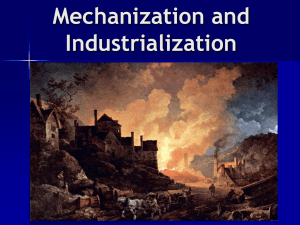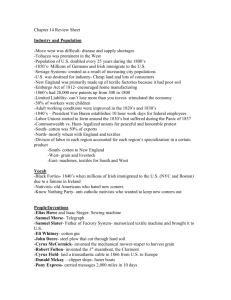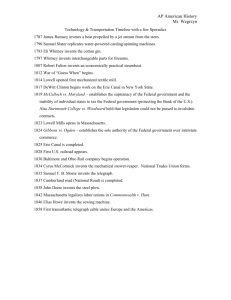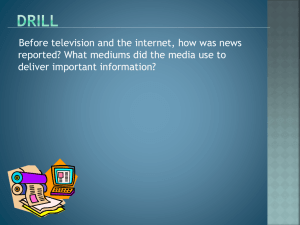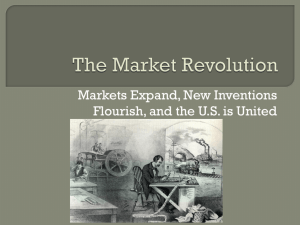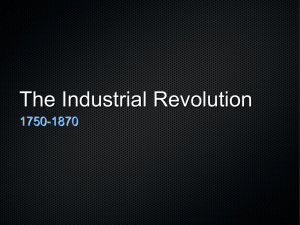The Industrial Revolution 2 - SGBIS-Y6
advertisement
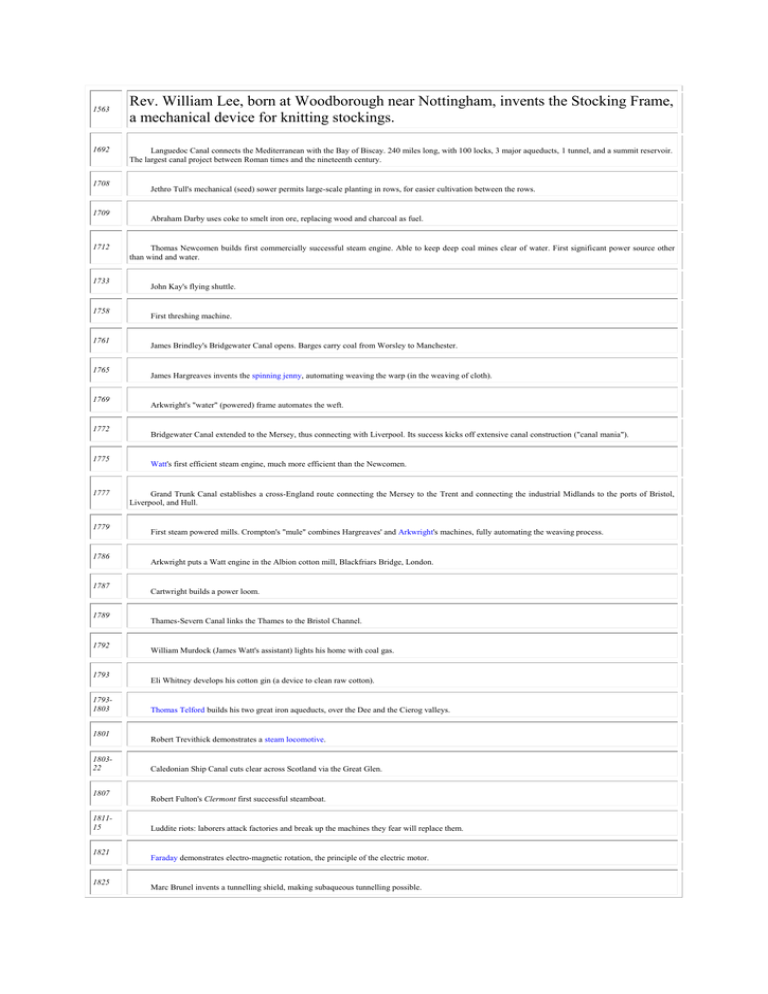
1563 1692 1708 1709 1712 1733 1758 1761 1765 1769 1772 1775 1777 1779 1786 1787 1789 1792 1793 17931803 1801 180322 1807 181115 1821 1825 Rev. William Lee, born at Woodborough near Nottingham, invents the Stocking Frame, a mechanical device for knitting stockings. Languedoc Canal connects the Mediterranean with the Bay of Biscay. 240 miles long, with 100 locks, 3 major aqueducts, 1 tunnel, and a summit reservoir. The largest canal project between Roman times and the nineteenth century. Jethro Tull's mechanical (seed) sower permits large-scale planting in rows, for easier cultivation between the rows. Abraham Darby uses coke to smelt iron ore, replacing wood and charcoal as fuel. Thomas Newcomen builds first commercially successful steam engine. Able to keep deep coal mines clear of water. First significant power source other than wind and water. John Kay's flying shuttle. First threshing machine. James Brindley's Bridgewater Canal opens. Barges carry coal from Worsley to Manchester. James Hargreaves invents the spinning jenny, automating weaving the warp (in the weaving of cloth). Arkwright's "water" (powered) frame automates the weft. Bridgewater Canal extended to the Mersey, thus connecting with Liverpool. Its success kicks off extensive canal construction ("canal mania"). Watt's first efficient steam engine, much more efficient than the Newcomen. Grand Trunk Canal establishes a cross-England route connecting the Mersey to the Trent and connecting the industrial Midlands to the ports of Bristol, Liverpool, and Hull. First steam powered mills. Crompton's "mule" combines Hargreaves' and Arkwright's machines, fully automating the weaving process. Arkwright puts a Watt engine in the Albion cotton mill, Blackfriars Bridge, London. Cartwright builds a power loom. Thames-Severn Canal links the Thames to the Bristol Channel. William Murdock (James Watt's assistant) lights his home with coal gas. Eli Whitney develops his cotton gin (a device to clean raw cotton). Thomas Telford builds his two great iron aqueducts, over the Dee and the Cierog valleys. Robert Trevithick demonstrates a steam locomotive. Caledonian Ship Canal cuts clear across Scotland via the Great Glen. Robert Fulton's Clermont first successful steamboat. Luddite riots: laborers attack factories and break up the machines they fear will replace them. Faraday demonstrates electro-magnetic rotation, the principle of the electric motor. Marc Brunel invents a tunnelling shield, making subaqueous tunnelling possible. 182642 1827 1830 1831 Brunel builds the first subaqueous tunnel, under the Thames. Berkeley Ship Canal connects Sharpness (on the Severn) to Gloucester. The Liverpool and Manchester Railway begins first regular commercial rail service. Faraday discovers electro-magnetic current, making possible generators and electric engines. 1834 Charles Babbage develops Fox Talbot produces photographs. 1837 Morse develops Great Western--first ocean-going steamship. 1838 1839 1843 his analytic the engine--the telegraph forerunner of and Morse Great Britain--first large, iron, screw-propelled steamship. 1846 Pneumatic First telegraph cable laid under the Channel. tire Petrol (gasoline) Natural Science Honours School established at Oxford. 1851 Singer invents Natural Sciences Tripos at Cambridge. 1856 1857 refining first machine. Pasteur experiments with fermentation. Charles Darwin, The Edwin Drake strikes Etienne Lenoir demonstrates the first successful gasoline engine. 1873 sewing W.H. Perkin produces aniline dyes, permitting brightly colored cottons. 1859 1867 practical used. Regius Chair of Technology founded at Edinburgh. First Cathode rays discovered. 1863 first Bessemer invents steel converter. 1858 1860 patented Monier develops reinforced concrete. 1850 1855 Code. Fox Talbot introduces photographic paper. Commercial use of Morse's telegraph (Baltimore to Washington). 1854 computer. Daguerre perfects the Daguerrotype. 1844 1849 the Trans-Atlantic Cable Origin oil completed of in Species. Pennsylvania. Science degrees at University of London. Siemens-Martin open hearth process (along with the Bessemer converter) makes steel available in bulk. Steel begins to replace iron in building: steel framing and reinforced concrete make possible "curtain-wall" architecture--i.e., the skyscraper. Alfred Nobel produces dynamite, the first high explosive which can be safely handled. Christopher Sholes invents James Clerk Maxwell states the laws of electro-magnetic radiation the Remington typewriter. 1876 1877 1878 1879 1883 1884 1885 1888 1889 1892 1895 1896 1897 1899 1900 1901 1903 1908 Bell invents the telephone. Edison invents the phonograph. Microphone invented. Edison invents the incandescent lamp. First skyscraper (ten stories) in The Brooklyn Bridge opens. This large suspension bridge, built by the Roeblings (father and son), is a triumph of engineering. Chicago. Maxim invents the machine gun, making possible mass slaughter and beginning the mechanization of warfare. Benz develops first automobile to run on internal- combustion engine. Hertz produces radio waves. Eiffel Tower. Rudolf Diesel invents his namesake. Lumière Roentgen discovers X-rays. brothers Marconi patents wireless telegraph. Joseph Thomson discovers particles smaller than atoms. Aspirin invented. First Zeppelin built. Marconi transmits first trans-Atlantic radio message (from Cape Cod). Wright brothers make first powered flight. Henry Ford mass-produces the Model T. develop Cinematograph.
